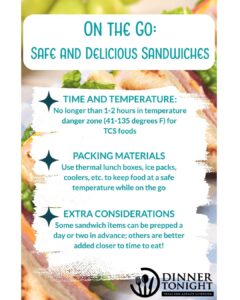 Sandwiches are a classic for both picnics and easy on-the-go lunches. But some simple tweaks can help you build a healthier sandwich!
Sandwiches are a classic for both picnics and easy on-the-go lunches. But some simple tweaks can help you build a healthier sandwich!
Starting with whole grain is a great first step.
USDA MyPlate Guidelines recommend that you make half your grain choices whole grain ones each day, and using whole grain sandwich bread is a fantastic way to get more fiber and other beneficial nutrients in, while giving your body sustainable energy that keeps you satisfied longer and helps stabilize your blood sugar.
Trade deli meats for other lean meat choices
Deli meats are typically high in sodium, saturated fat, and also nitrates and nitrites, which all can contribute to health concerns like high blood pressure and high cholesterol. Subbing in lean protein choices, such as roasted or grilled chicken or turkey, is a great way to add some filling protein without the drawbacks. It also gives you the chance to season it the way you prefer and customize your sandwich flavors!
Consider your cheese choice.
Cheese can be a delicious addition to your sandwich, but is another ingredient that can quickly add a larger amount of sodium and saturated fat, even in small servings (just 1 oz of cheddar cheese can contain around 5 oz of saturated fat!). Cheeses that tend to be the highest in sodium include American cheese, feta, parmesan, and blue cheese. It’s important to read labels on low-fat cheeses, because they also often have higher levels of sodium to make up for taste loss with the reduction of fat. Lower fat and sodium cheese choices include ricotta, goat cheese, Swiss cheese, cottage cheese, and fresh mozzarella. Another way to cut the sodium and saturated fat is to use cheese sparingly, more like a garnish than a main sandwich component!
Fill in with fresh vegetables.
Sandwiches are perfect vehicles for a variety of fresh veggies! Adding vegetables to your sandwich makes them more visually appealing, adds fun flavor and crunch, and greatly increases the nutrient density. Consider adding cucumbers, fresh greens, chopped or grated carrots, sliced tomatoes or avocados, red onion rings, etc. to add more interest and nutrition to your sandwich!
Get creative with condiments.
Basic sandwich condiments include mustard and mayo, but you don’t have to stop there! Drizzle some vinegar and oil, make a simple smashed fruit spread, or add fresh herbs to elevate the flavor in a healthy and fun way!
What other ways do you like to customize your sandwich for max nutrition benefit and flavor?
 Sandwiches are a classic picnic main dish choice, but there are some things to consider to make them both safe AND delicious!
Sandwiches are a classic picnic main dish choice, but there are some things to consider to make them both safe AND delicious!
Time and Temperature.
If you’re using foods that need refrigeration (also called Time/Temperature Control for Safety or TCS foods), remember to take steps to avoid the temperature danger zone (41-135 degrees). This means making a plan to eat them quickly or keep your cold sandwiches cold (below 41 degrees) if you plan to be out longer than 2 hours with them (or longer than 1 hour if the outside temp is over 90 degrees!).
Packing Materials.
There are lots of options for what to pack your sandwich in. The classic wicker basket is cute for picnic pictures, but doesn’t keep your food properly chilled without some help! Make sure you bring other solutions, like coolers, thermal lunch boxes with ice packs, etc. to help maintain safe temperatures. Plastic sandwich bags and reusable sandwich wraps (like beeswax ones) CAN be washed and used multiple times as long as you make sure they are properly cleaned after each use and not used for containing raw meats, fish, eggs, or other hazardous foods. If you have an especially hefty sandwich, or one with ingredients that tend to fall out, cooking twine or toothpicks can be a handy solution for holding your sandwich together!
Extra Considerations.
Many sandwiches can be prepped in advance and stored safely in the refrigerator. For best quality, it’s recommended to eat them about 3 days after you prepare them. Some sandwich components, especially saucy condiments and some fruits and vegetables with a lot of moisture are best left off until the day you plan to eat them. Pro-tip: to prevent these ingredients from making your bread too soggy, layer these on top of spread cheese, on a bed of greens, or between your meat and cheese slices to add a layer of protection!

